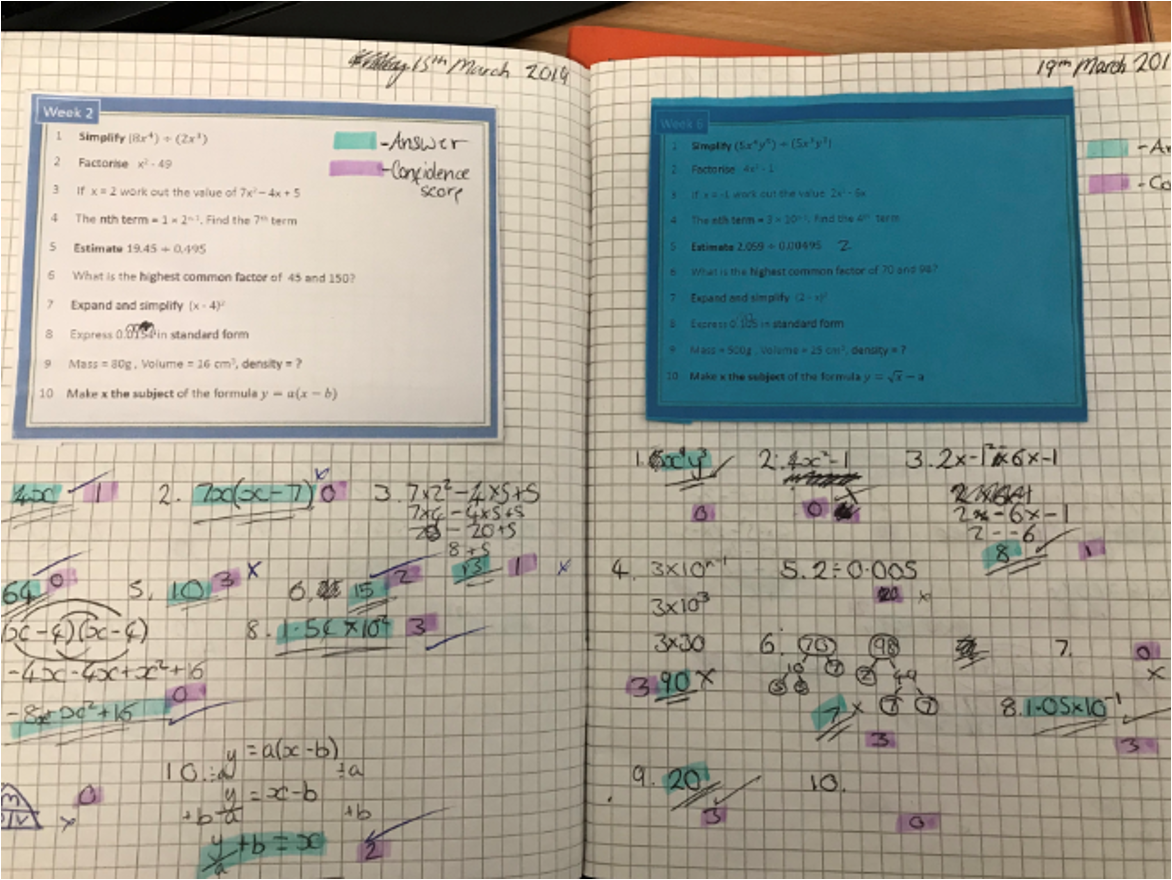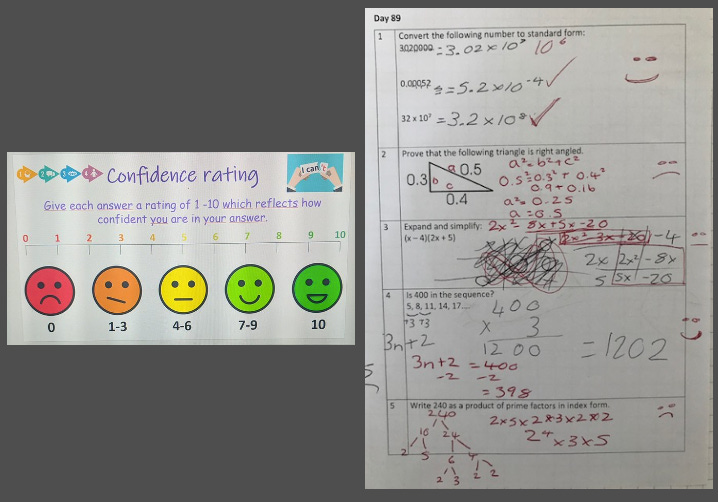How confidence scores can increase learning
Let's tap into the surprising power of the hypercorrection effect
This newsletter is made possible by Eedi. Check out our brand-new set of diagnostic quizzes, videos, and practice questions for every single maths topic, ready to use in the classroom, and all for free, here.
I have long been interested in the role confidence plays in learning. During my research for How I wish I’d taught maths, I experimented asking my students to put confidence scores (0 to 10) on their answers to Low-Stakes Quizzes before we marked them. In 2021, I co-authored a research paper on the positive effect assigning these confidence scores can have on student achievement. In this post, I’d like to share my recent thinking and ideas around the role of confidence scores, just in case you’d like to give it a go.
Six reasons why asking students to assign confidence scores to their answers is a good thing
1. Confidence scores increase the potency of the Hypercorrection Effect
The Hypercorrection Effect is the finding that errors endorsed with higher confidence are more likely to be corrected on a final test than those with lower confidence. You can read one of Janet Metcalfe’s original papers here, and an excellent summary by InnerDrive here.
The problem is, I don’t think many students naturally pause and reflect on how confident they feel about an answer. Most students I have taught or observed simply complete a question and then move on to the next. If a student only finds out that they are wrong later in the lesson when the teacher goes through the answers, they may not remember how they felt about that particular question and hence not experience the surprise needed to kick-start the Hypercorrection Effect.
My hypothesis, which I hope to test soon using data from Eedi, is that by explicitly asking students to assign confidence scores, we compel them to consider just how they feel about an answer, even if that moment of reflection comes later in a lesson. This then increases the potency of the subsequent Hypercorrection Effect.
2. Confidence scores help students know what they know, not what they think they know
Students often overestimate their understanding of a concept. Relax, sir. Of course, I know how to add fractions. If this confidence is misplaced, students may not bother to practice or revise certain areas because they believe they have mastered them.
Asking students to assign confidence scores overcomes this by revealing areas where students have drastically overestimated their capabilities. The fancy term for this is it increases metacognitive awareness.
3. Confidence scores help students invest more in their answers
Once you have committed to saying you feel confident about an answer, you have skin in the game. Suddenly, that answer means something to you, and you are eager to find out whether you are right. Furthermore, if you find out that you are wrong, that moment of surprise prompts you to figure out your mistake and make subsequent corrections.
I saw this in action when a student was working on a practice GCSE exam paper.
Notice that she has indicated with a 10 that she is very confident about her answer to the triangular prism question.
But she has made a mistake. She has forgotten to divide by 2. When the teacher went through the answers, I saw her jaw drop. She turned to her partner to see if they had made the same mistake, and then she picked up her pink pen and began frantically making corrections.
Her answer meant something to her, and I believe assigning a confidence score heightened that meaning.
4. Confidence scores give a priority order to making corrections
Look at this student’s assessment:
The teacher has marked it, and now students spend the next lesson making corrections. The question is, where should the student start? They haven’t got a single question correct.
Most students will start thinking about the first question they got wrong and go from there, often running out of time before finishing all their corrections.
But that is an inefficient use of this limited amount of time. The Hypercorrection Effect tells us that errors made with high confidence will likely lead to the most significant learning gains when corrected. So if the student had assigned confidence scores to his test, he might have found, for example, that he was really confident about his answer to Q6, and thus that is where he should allocate his time before moving on to his second-most confident error.
The student below student did precisely that, indicating their confidence score in the square boxes next to each question:
They know they don’t know how to do simultaneous questions (Q3), but think they have nailed long division (Q4). When they come to make corrections, Q4 is where they need to start.
5. Confidence scores give useful information to the teacher
It is not just the students that can benefit from assigning confidence scores.
Let’s imagine we ask students to add three-fifths and one-quarter.
We tell our students to do their working out on the back of their mini-whiteboards, write their answers nice and big in the centre of the front of their boards, and write their confidence scores (0 to 10, with 10 representing the highest level of confidence) in a box in the top-right-hand corner. Now, imagine these are four of the boards we see when students show us their answers:
This gives us some valuable information we could use when choosing which students to call upon to explain their answers.
Who would you call upon, and in which order?
Here is one possibility:
Board 1 - No response: We could ask this student first to determine whether the response is due to a lack of effort or understanding.
Board 2 - High-confidence error: We could call upon this student next to make a common misconception explicit. We must also return to this student at the end of the questioning process to ensure they can identify their mistake and articulate the correct process so they may benefit from the Hypercorrection Effect.
Board 3 - Low-confidence correct answer: Calling upon this student next may prove a magical moment as they realise that, despite their doubts, they are correct and are probably better at maths than they think.
Board 4 - High-confidence correct answer: This could be the final student we ask as they may provide a robust explanation that others can learn from.
6. Confidence scores can reduce the amount of silly mistakes students make
Here is a nice bonus one to finish…
If you use confidence scores, don’t ask students to assign them as they go; instead, do it at the end before the answers are revealed. This encourages students to go back and review their work to remind themselves how confident they felt about a particular answer. During this review, students often spot a silly mistake they have made.
I find this infinitely more effective than saving to students: Now go back and check your work - I know of no other string of 7 words that students ignore more.
What can confidence scores be used for?
In short, anything where students have answered a question but don’t yet know whether it is correct. Here are some things I have used confidence scores for:
Low-Stakes Quizzes
Independent practice in class
Mini-whiteboard work
Homework
Mock exams
Actual exams - this may help students review questions more carefully and thus reduce those annoying daft mistakes
I especially like this example where a teacher marked a set of Mock Exams where students had assigned confidence scores to each question. Next lesson, students were asked to find their 3 highest confidence errors and see if they could work with their partner to correct them:
Does it matter what confidence scale I use?
I don’t think so. So long as the scale allows students to distinguish between high and low confidence errors, you are good to go. Here are some examples from schools I have worked with:
Confidence score top tips:
Tell students why you are asking them to add confidence scores to their work.
Get them to assign confidence scores when they have finished their work, as opposed to as they go through it. This will make them take the process more seriously and give them an extra opportunity to review their work and spot any mistakes.
Ban a score of 5. If you use a 0 - 10 scale, you will find lots of students play it safe and stick down a 5. Banning scores of 5 forces students to say whether they are more or less confident
Experiment with a confidence-based scoring system. If a student puts an 8 for their confidence level, they score 8 points if they are correct but lose 8 points if they are wrong. This can be a bit of fun and provide an incentive to be accurate with their assignment of conference scores.
Conclusion
Assigning confidence scores is a low-cost strategy, both in terms of time and moment, that has the potential to lead to significant learning gains. If you are up for it, give it a try!
What has been your experience of using confidence scores?
Are their any ideas here that you are excited to try out?
Let me know in the comments below!
🏃🏻♂️ Before you go, have you…🏃🏻♂️
… checked out our incredible, brand-new, free resources from Eedi?
… read my latest Tips for Teachers newsletter about planning follow-up questions in advance?
… listened to my most recent podcast with Kris Boulton about Atomisation?
… considered booking some CPD, coaching, or maths departmental support?
… read my Tips for Teachers book?
Thanks so much for reading and have a great week!
Craig











I've used this with my Year 6 classes since I read it in your book a few years ago. We use a 1, 2 or 3 and I introduce it with a corresponding face emoji. It really works to help them go back to check their answers. The children use it for all tests, including English ones.
Love this! I remember reading this in your book when I did my NPQML on Math Anxiety. I added it to the LSQ routine and have since forgotten about this little nugget. It is coming straight back in to my routine now!